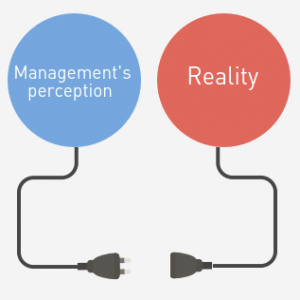- John Wellwood
- September 11th, 2017
In last week’s article, ‘Implementing change successfully: the first key step to success’, I explained that to implement a successful change, we need at least 75% of employees to understand why the change is necessary. In that article, I touched on why we, as managers, are so poor at achieving this number. This week, I want to hone in on some of the reasons why management teams find it so hard to explain the need for change and help you overcome this.
So, here are the four most likely reasons you’re failing to implement change successfully:
 Employees are not made aware of what is really going on
Employees are not made aware of what is really going on
While managers are made privy to company reports, presentations and discussions on a daily basis, most other employees won’t
have a clear view of what is happening in their company. They won’t know the financial situation or really understand the market and their competitors. They won’t know what customers’ demands are or how well their organisation meets them and because of this, they won’t understand the problems or issues the company is facing. This means that when managers are told that a change is needed they are quickly able to identify the why, while those who are kept in the dark will take far longer to identify and accept the need for change.
Given the choice, many managers will take the easy option and avoid upsetting the equilibrium by shielding information from their employees. However, to truly be able to convince other employees of the need for change, organisations must be open and honest, and issues must be communicated early on in the process.
 Managers don’t understand the reality of their own business
Managers don’t understand the reality of their own business
While they may know the facts and figures behind the business, I’ve come across many managers who can’t articulate the real need for change as they simply don’t know what is really happening in their own organisation. In a small business, it is easy to keep on top of day-to-day activity because there are so few team members. However, as a business grows, this proves more and more difficult and managers can soon get wrapped up in their own function. Unfortunately, this disconnect between what management thinks is going on in the business and the reality of what is actually going on, is a sure-fire killer for any change programme.
No matter how well management can communicate the need for change, the given reason will not resonate with employees if their day-to-day experience is so different from what management perceives it to be. The result is a lack of understanding and a slowdown in the whole process. So, before you embark on any change in a company, I would urge you to do some data collection, diagnostics and analysis to ensure you are starting from the right point. Spend some time in your business talking to people, understanding their problems and observing the operations in practice. This observational activity is often called a Gemba walk – going to the shop or office floor and taking time to develop a clear understanding of each part of the business.
 We don’t understand what our people do, what they go through and what motivates them
We don’t understand what our people do, what they go through and what motivates them
To explain the need for change and get your team to truly understand it, you must communicate from the perspective of your staff at each level or area in the business. Of course, this proves pretty difficult if you don’t really understand your staff…
Every person in your business will have a different motivation for doing their job. Management must strive to understand what this motivation is and take time to appreciate what they do on a day-to-day basis. Only once you achieve that, can you communicate the change in a way that they will understand and effectively communicate how the change will be of benefit to them. To do this you must spend time with your people.
The Gemba walk I suggested in the previous point will provide you with some understanding of what employees do, but it’s also important to spend time in the life of your people. Experience what they experience and adopt their perspective. Ask yourself questions such as: Do they have the right tools to complete their function well? Are the conditions good enough? Do they receive sufficient support? In short, real leaders observe, understand and support their people regularly, so when it comes to change, they can communicate the ‘why’ with ease.
 We can’t communicate as well as we think we can
We can’t communicate as well as we think we can
One of the most common reasons why managers fail to explain the need for change effectively is that they simply struggle to communicate in a way that resonates with their employees. Often, messages are lost in boring presentations filled with data and graphs and tend to use unnecessarily complex words. Whether it’s because managers don’t communicate regularly, have no relationship or rapport with their staff, or can’t adapt to the needs of their team, it’s an invisible barrier that can block all improvement initiatives from moving forward.
There is no alternative; leaders, managers and change managers need to be exceptional communicators and presenters, both in one-to-one and group situations. Everything from the timing to the tone must be right. You need to use the right language and style, and select your words carefully. You must put in place feedback mechanisms and be prepared to answer un-asked questions. You must be able to show you understand the world of the employee and emphasise with the impact that the change will have. Ultimately, you need to plan what you are going to say, adapt it to suit your audience and, crucially, listen to the feedback.
By overcoming the four points explored in this article, managers will increase their ability to communicate the need for change and increase the likelihood of achieving that all-important 75% employee acceptance. If you recognise a gap in your knowledge or skill-set that may put you at risk of falling foul to one of the four points, then click the button below to explore our wide range of change management training courses or get in touch to discuss your needs.
Look out for the third in the ‘Implementing change successfully’ series, in which I’ll be exploring one major barrier that may be standing in your way when trying to implement your change initiative. In the meantime, if you have any questions about this article or change management, be sure to comment below or reach out to me on Twitter.


 Employees are not made aware of what is really going on
Employees are not made aware of what is really going on
 Managers don’t understand the reality of their own business
Managers don’t understand the reality of their own business
 We don’t understand what our people do, what they go through and what motivates them
We don’t understand what our people do, what they go through and what motivates them
 We can’t communicate as well as we think we can
We can’t communicate as well as we think we can
